Indonesian Navy
The Indonesian Navy (Indonesian: Tentara Nasional Indonesia-Angkatan Laut (TNI-AL), literally "Indonesian National Military-Naval Force") is the naval branch of the Indonesian National Armed Forces. It was founded on 10 September 1945 and has a role to patrol Indonesia's lengthy coastline, to enforce and patrol the territorial waters and Exclusive Economic Zone (EEZ) of Indonesia, to protect Indonesia's maritime strategic interests, to protect the islands surrounding Indonesia, and to defend against seaborne threats.
| Indonesian Navy | |
|---|---|
| Tentara Nasional Indonesia-Angkatan Laut TNI-AL | |
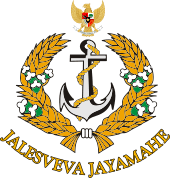 TNI-AL insignia | |
| Founded | 10 September 1945 |
| Country | |
| Allegiance | |
| Type | Navy |
| Size | 74,000 active duty personnel |
| Part of | |
| Headquarters | Cilangkap, Jakarta |
| Nickname(s) | TNI-AL |
| Motto(s) | Jalesveva Jayamahe (Sanskrit, lit: "Victorious on the Sea") |
| Colors | Navy blue |
| March | Mars Jalesveva Jayamahe |
| Anniversaries | 10 September |
| Fleet |
|
| Engagements | Battle of Arafura Sea Operation Trikora Indonesia–Malaysia confrontation Incorporation of West Papua into Indonesia Indonesian Invasion of East Timor Insurgency in Aceh |
| Website | www |
| Commanders | |
| Commander-in-Chief | President Joko Widodo |
| Chief of Staff | Admiral Yudo Margono |
| Vice Chief of Staff | Vice Admiral Mintoro Yulianto |
| Insignia | |
| Flag |  |
| Naval Jack | 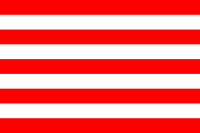 |
| Naval Aviation Roundel |   |
| Naval Ensign & Fin flash |  |
The Navy is headed by the Chief of Staff of the Navy (Kepala Staf Angkatan Laut – KSAL or KASAL). The Indonesian Navy consists of three major fleets known as "Armada" which are Komando Armada I (1st Fleet Command) located in Jakarta, Komando Armada II (2nd Fleet Command) located in Surabaya, Komando Armada III (3rd Fleet Command) located in Sorong, and one Komando Lintas Laut Militer (Military Sealift Command). The Navy also heads the Marine Corps.
All commissioned ships of the TNI-AL have the prefix KRI, standing for Kapal Republik Indonesia (Republic of Indonesia Ship) and KAL, standing for Kapal Angkatan Laut (Navy Ship) for smaller boats which have a length less than 36m, and made from fiberglass.
Mission
According to Article 9 of Law No.34/2004 on the National Armed Forces, the Navy has the following tasks:[1]
- perform military duties in national defence;
- enforce the law and secure the order in the sea area of national jurisdiction in accordance with national laws and ratified international laws;
- perform diplomatic duties in support of foreign policy set by the government;
- engage other duties relevant for the maintenance and development of naval power;
- support civilian empowerment in sea defence areas.
History
Creation and actions during the revolution
The official Indonesian Navy's history began on 10 September 1945, at the outset of the Indonesian National Revolution. The administration of the early Indonesian government established the People's Marine Security Agency (Badan Keamanan Rakyat Laut/ BKR Laut) on 22 August 1945, the predecessor to the modern Indonesian Navy. BKR Laut with only wooden ships, a few landing craft and weapons left by Japan, was initially composed of Indonesian sailors who had served in the ranks of the Royal Netherlands Navy during the Dutch colonial period, and who had fought the Japanese during the years of military occupation, plus active militias who served with the Japanese and ex-Indonesian officers and ratings of the Imperial Japanese Navy. The formation of the Indonesian military organisation known as the People's Security Army (Tentara Keamanan Rakyat / TKR) on 5 October 1945, at the height of the National Revolution, helped spur the further existence of the TKR Naval Branch – the Peoples' Security Navy (TLKR), which later became the Republic of Indonesia Navy (Angkatan Laut Republik Indonesia/ ALRI). The name ALRI was used until 1970, when it was changed to Tentara Nasional Indonesia Angkatan Laut (TNI-AL).[2]
As the revolution grew and the Navy began its work, naval bases were established throughout the archipelago. Former ships of the Imperial Japanese Navy handed down to the new republic were acquired. Simple strength did not discourage the Navy to deploy Sea Traffic Operations in order to spread the news of the proclamation and helping to form and train Republican military forces and militias nationwide. Besides, they also attempted to breach the Dutch naval blockade in order to obtain aid from abroad.
The newly formed navy confronted the more superior Royal Netherlands Navy in Bali, Sibolga and Cirebon. Cross-sea operations are also able to prepare the armed forces in South Kalimantan, Bali and Sulawesi. Limitations in strength and ability to lead the Navy had to divert the struggle in the countryside, after most boats were sunk and nearly all bases battered by the Dutch and Allied military forces. But the determination to participate again in the sea never subsided. In the hard times during the National Revolution the Navy succeeded in forming the Fleet Forces (CA), Marine Corps (Corps Mariniers/ CM), and educational institutions in various places. The formation of these elements mark the presence of aspects for the formation of a modern national navy.
After the revolution

The end of the War of Independence marked the development of the Navy as a modern naval power. In accordance to the results of the Round Table Conference, in 1949, the Navy received a variety of war equipment such as warships and its supporting facilities such as naval bases. This step in the consolidation of the body along with the Navy, revamping the organization and recruitment of personnel through educational institutions before manning naval equipment. During 1949–1959, the Indonesian Navy managed to enhance its strength and improve its capabilities. In the field of organization the navy reorganized its Fleet Forces, the Marine Corps – then Korps Komando Angkatan Laut (KKO-AL – Naval Commando Corps Command), naval aviation and a number of regions as territorial defense command aspects of the sea. Navy combat equipment grew, both from the Dutch and from other various countries.
With the increased strength and the capability, the Navy began refining the strategy, tactics, and techniques of marine operations, which are directly applied in a variety of military operations in order to deal with separatist movements that have sprung up in the year from 1950 to 1959. In operations against PRRI in Sumatra, Permesta , Darul Islam in West Java, and RMS in the Moluccas, the Navy gained lessons in applying the concept of marine operations, amphibious operations, and joint operations with other forces.
At the height of the Cold War
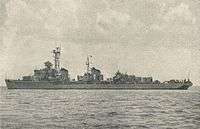
At the time the country started to recover from the threat of disintegration, in 1959, the Navy launched a program known as Menuju Angkatan Laut yang Jaya (rough translation - "Toward Distinguished Navy"). The Navy experienced a significant progress until 1965 which was motivated by the politics of confrontation in order to seize West Irian, which Indonesia claimed as part of its territory, a claim refuted by the Dutch government. As part of the increasing military ties between Indonesia and the Warsaw Pact, various naval combat equipments from Eastern European countries strengthened the Navy and become the dominant force at the time. Some military equipment of Soviet production served in the ranks of the Navy, among others Sverdlov-class cruiser, Skoryy-class destroyer, Riga-class frigate, Whiskey-class submarine (the first such vessels to be used in Southeast Asia), Komar-class missile boat, Ilyushin Il-28 long-range bomber aircraft of Naval Aviation and the PT-76 Amphibious light tanks, BTR-50 APCs and BM-13 MRLs (Southeast Asia's first ever MRL system in service) of the Commando Corps, the first of their kind in the region. With such power in the era of the 1960s the Navy was called the largest Navy in Southeast Asia and one of the strongest within the Asia-Pacific, outranking those of its neighbors in armament and prestige.
By January 1962 the Indonesian Navy started preparing a couple of naval operations for the liberation of West Irian known as Operation Trikora, which began on 15 December the year before as part of the military component of that operation under the Mandala Command for the Liberation of West Irian (Komando Mandala Pembebasan Irian Barat) . Beginning 1 January, fast-ship torpedo vessels of the Navy were forward deployed to deal with destroyers, frigates and aircraft of the Royal Netherlands Navy. On January 15, 1962 Commodore Yos Sudarso along with RI Macan Tutul sank in the sea battle in the Arafura Sea. This battle is known as the Vlakke Hoek incident.By mid-year the Navy was preparing to organize its role in the planned Operation Jayawijaya which would have been the largest amphibious operation in the history of Indonesian military operations if commenced. The naval component was made up of 100 warships and 16,000 sailors and Marines. The deployment of forces preparatory to the planned landings in West Papua forced the Dutch to return to negotiations and reached an agreement to hand over West Irian to Indonesia.
After seizing West Irian, Sukarno by 1963 moved his sights on Malaysia. Indonesia political confrontation against Neocolonialism and Imperialism (Nekolim) continued in Operation Dwikora to oppose the formation of Malaysia. Although elements of the National Armed Forces were prepared for operational deployments to the new state, the operations were limited to the infiltration operation along the Borneo frontier. Soldiers from the marine corps were involved in the operations which targeted both the Malaysian states of Sabah and Sarawak. The Marine Corps, though, would figure in the 1964 MacDonald House bombing in Singapore.
1965 onwards
_underway_in_the_Pacific_Ocean%2C_circa_in_1971_(K-88514).jpg)
Operation Dwikora was discontinued in 1965 along with a succession of governments in Indonesia after an abortive coup d'état[3] took place in Jakarta, which were organized by the self-proclaimed organization of Indonesian National Armed Forces members who, in the early hours of 1 October 1965, assassinated six Indonesian Army generals and killed 3 more. Since 1966, the Navy experienced a new chapter in its history as the military integration efforts. With the integration of the armed forces organizationally and operationally been able to keep up on the implementation of tasks in the field of defense and security so doctrinally, the direction of development of the power and capabilities of each branch to be concentrated. The operations were prominent during the period of the 1970s was Operation Seroja in the framework of the integration of East Timor to Indonesia. The Navy played an active role in the operation of landings, a joint ground operation, and transporting troops by sea.
Starting the 1980s the Navy began to modernize combat equipment. Ships made in Eastern Europe that has been the core strength of the Navy in the era of the 1960s and 1970s were not suited to meet the growing and changing needs for the navy and its branches (saving for its submarines and several corvettes and frigates, the submarines were retired in 1990). The worsening relations between Indonesia and the Soviet Union after the government of President Sukarno resulted a cessation of military cooperation between the two countries and the Warsaw Pact. Therefore, the Navy switched once more to using Western technology to modernize the power and ability to buy warships, logistics vessels and other major combat equipment from various countries. Included among those commissioned during the Suharto presidency were Fatahillah-class corvette and Van Speijk-class frigate from the Netherlands, Type 209 submarine from West Germany, fast patrol boat from South Korea, and the GAF Nomad patrol aircraft from Australia. In 1993 the Navy also received 39 ships from the former Volksmarine (East German Navy), including 16 Parchim-class corvettes, 14 Frosch-class landing ship tanks (LSTs), and 9 Kondor II-class minessweepers. Aside from these the Navy reorganized its forces. In 1984, as part of an-Armed Forces wide unit reorganization, the former Naval Regions, which in turn governed Naval Bases and Naval Districts and subordinate Naval Stations and Naval Air Stations, were turned into Main Naval Bases of the Navy Fleet Commands, divided from the formerly unified National Fleet Command.
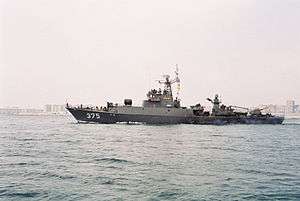
At the same time the Navy began to develop a non-combat military operations in the form of humanitarian service program Surya Bhaskara Jaya in various remote areas in Indonesia that can only be reached by sea. The core of the operating activities are health services, construction and rehabilitation of public facilities and various counseling in health, law, and civil defense. This event is held regularly every year until now. A number of countries also participated in these activities, among others, Singapore, Australia and the United States. The navy also seeks promoting the development of the maritime sector, especially those related to aspects of defense and security at sea, activities that had been present since independence before the formation of the Ministry of Maritime Affairs and Fisheries. The actual activities undertaken today by the Navy are establishing marine development assessment bodies together with the government and private sectors in some areas, coastal village pilot programs are summarized in Coastal Rural Development (Bindesir), and the National Potential Development Program for Maritime Defense (Binpotnaskuatmar). In order to encourage the spirit of the seafaring nation, the Navy held an international scale maritime event Arung Samudera 1995. The navy was responsible for the programs for National Maritime Year 1996 and the Bunaken Declaration of 1998, which is a manifestation of marine development in Indonesia.
Expansion in the 21st century
During the presidencies of Susilo Bambang Yudhoyono and Joko Widodo, the Navy has begun a program of expansion of its combat commands and has begun a program of national warship construction in naval arsenals, while acquiring nationally produced transport aircraft for the needs of the Navy.
Organisation
According to presidential decree No. 66/ 2019,[4] the organizational structure of the navy comprises the following components:
Leadership Elements
- Chief of Staff of the Navy, position held by a four-star admiral or marine general.
- Vice Chief of Staff of the Navy, position held by a three-star admiral or marine general.
Assistant for Leadership Element
- Inspector General of the Navy, position held by two-star admiral.
- Chief of Staff Advisor, position held by two-star or one-star admiral.
- Naval Planning and Budgeting Advisor
- Naval Intelligence Advisor
- Naval Operation Advisor
- Naval Human Resource Advisor
- Naval Supply Advisor
- Marine Potential Advisor
- Naval Communication and Electronics Advisor
Central Executive Agencies

- Indonesian Naval Academy Surabaya (Akademi TNI Angkatan Laut/ AAL)
- Naval Command and Staff College (Sekolah Staf dan Komando Angkatan Laut / Seskoal)
- Naval Aviation Center (Pusat Penerbangan Angkatan Laut / Puspenerbal)
- Naval Military Police Center (Pusat Polisi Militer TNI Angkatan Laut)
- Naval Frogman Commando Center (Pusat Komando Pasukan Katak TNI Angkatan Laut)
- Naval Security and Signals Departement (Dinas Keamanan dan Persandian TNI Angkatan Laut)
- Naval Public Relations Department (Dinas Penerangan TNI Angkatan Laut)
- Naval Communication and Electronics Department (Dinas Komunikasi dan Elektronika TNI Angkatan Laut)
- Naval Justice Department (Dinas Hukum TNI Angkatan Laut)
- Naval Operations and Training Department (Dinas Operasi dan Latihan TNI Angkatan Laut)
- Naval Marine Potential Development Department (Dinas Potensi Maritim TNI Angkatan Laut)
- Naval Personnel Administration Department (Dinas Administrasi Personal TNI Angkatan Laut)
- Naval Education Department (Dinas Pendidikan TNI Angkatan Laut)
- Naval Personnel Maintenance Department (Dinas Perawatan Personel TNI Angkatan Laut)
- Naval Medical Department (Dinas Kesehatan TNI Angkatan Laut)
- Naval Ordnance Department (Dinas Materiil TNI Angkatan Laut)
- Naval Weapons and Electronics Equipment Department (Dinas Materiil Senjata dan Elektronika TNI Angkatan Laut)
- Naval Seaworthiness Department (Dinas Kelaikan TNI Angkatan Laut)
- Naval Base Facility Department (Dinas Fasilitas Pangkalan TNI Angkatan Laut)
- Naval Procurement Department (Dinas Pengadaan TNI Angkatan Laut)
- Naval Supply Department (Dinas Pembekalan TNI Angkatan Laut)
- Naval Finance Department (Dinas Keuangan TNI Angkatan Laut)
- Naval Research and Development Department (Dinas Penelitian dan Pengembangan TNI Angkatan Laut)
- Naval Information and Data Processing Department (Dinas Informasi dan Pengolahan Data TNI Angkatan Laut)
- Naval Psychology Department (Dinas Psikologi TNI Angkatan Laut)
- Naval History Department (Dinas Sejarah TNI Angkatan Laut)
- Naval Chaplaincy Department (Dinas Pembinaan Mental TNI Angkatan Laut)
- Naval Technological College (Sekolah Tinggi Teknologi TNI Angkatan Laut)
.jpg)
Naval Aviation
The Naval Aviation Centre (Pusat Penerbangan Angkatan Laut - Puspenerbal) is a part of the Navy's Central Executive Agencies led by a Rear Admiral (upper half). Puspenerbal as the center of guidance to the Navy's aviation units in the field of personnel as well as the readiness of air elements. Puspenerbal is not just a combat unit, but also participates in various Marine Corps operational tasks as well as providing logistics and personnel tactical transport facilities for marine and airbase systems. In carrying out these tasks, Puspenerbal carries out flight functions which include: Air surveillance, anti-submarine, fast logistics support, maritime patrol, marine combat operations, and the provision of material coaching functions. This unit is in charge of supporting naval operations, both for combat operations, SAR operations and humanitarian relief operations. Marine security to monitor the movement of foreign ships, especially in the archipelagic sea lanes of Indonesia, environmental protection from the pollution of dangerous materials, the prevention of smuggling and theft of marine wealth is also an important mission carried by Dispenerbal, in cooperation with other air force elements such as TNI-AU and Police. One of the most famous acts of Navy aircraft recently was when they were involved in evacuating victims of the 2006 Yogyakarta earthquake.
Principal Commands under the Chief of Staff of the Navy
- Fleet Commands :
The navy strength are spread across several Navy Main Naval Base (Pangkalan Utama TNI Angkatan Laut/ Lantamal) and Naval Base (Pangkalan TNI Angkatan Laut/ Lanal) throughout Indonesia under three main fleet command. Navy HQ assign numbering of Main Naval Base I to XI according to the location from west to east on August 1, 2006 in line with the inauguration of the Naval Base (Pangkalan TNI Angkatan Laut/ Lanal) Teluk Bayur in Padang, West Sumatra into Main Naval Base II. In 2015, three Naval Base (Lanal) were upgraded to Main Naval Base (Lantamal) with the numbering of XII, XIII and XIV. Plans exist to have a single HQ at Surabaya, with commands at Riau (West), Papua (East), and Makassar (Central).[5] JDW reported on 12 November 2003 that Admiral Bernard Kent Sondakh, the Chief of Naval Staff, was advocating a plan to merge the two fleets to form a single Main Operations and Administration Defence Command, to be headed by a three-star officer and headquartered at Surabaya.[6] Plans exist for the establishment of a central fleet command in Makassar – Celebes (Sulawesi) and also to move its eastern fleet to Sorong – Papua, these were officially accomplished as of 2018 when the 3rd Fleet Command was established.[7] Each Main Naval Base is organized into a number of naval bases and naval stations plus a number of naval air stations.- 1st Fleet Command (Komando Armada I /Koarmada I), in Jakarta, conterminous with Army's KODAM Jayakarta, KODAM Iskandar Muda and KODAMs I through III and XII and 1st Air Force Operational Command West.
- Main Naval Base I (Lantamal I) in Belawan, oversees naval bases covering Sabang, Dumai, Lhokseumawe, Tanjung Balai and Simeulue. The main naval base also oversee one Naval Air Station (Lanudal) Sabang and two facilities maintenance and repair (Fasharkan) in Sabang and Belawan. The main naval base is scheduled to be moved to Lhokseumawe in Aceh.
- Main Naval Base II (Lantamal II) in Padang, oversees naval bases covering Sibolga, Nias, Mentawai (planned), and Bengkulu.
- Main Naval Base III (Lantamal III) in Jakarta, oversees six naval bases covering Palembang, Cirebon, Lampung, Banten, Bandung, and Bangka-Belitung. Moreover, it has a maintenance and repair facility in Pondok Rowing, Jakarta. These maintenance and repair facility now has the ability to make small patrol boat with a size of 28–35 meters. Furthermore, the main naval base also oversees Naval Air Station (Lanudal) Pondok Cabe.
- Main Naval Base IV (Lantamal IV) in Tanjung Pinang oversees naval bases covering Batam, Tarempa, Ranai, Tanjung Balai Karimun, and Dabo Singkep. Main Naval Base Tanjung Pinang has a maintenance and repair facility or Fasharkan in Mentigi (Fasharkan Mentigi) that has the ability to make the patrol boat (KAL) 12, 28 and 35 meters. In addition, it has 2 Naval Air Station (Lanudal) in Matak, Natuna Islands, and in Tanjungpinang / Kijang.
- Main Naval Base XII (Lantamal XII) in Pontianak oversees naval bases covering Pangkalan Bun, Ketapang and Sambas.
- 2nd Fleet Command (Komando Armada II /Koarmada II), in Surabaya, conterminous with Army's KODAM IV through KODAM VI and KODAM IX, KODAM XIII and KODAM XIV and the 2nd Air Force Operation Command Central.
- Main Naval Base V (Lantamal V) in Surabaya oversees seven naval bases and one Naval Air Station, including Tegal, Cilacap, Semarang, Yogyakarta, Malang, Banyuwangi, Denpasar, and Batuporon.
- Main Naval Base VI (Lantamal VI) in Makassar, in charge of naval bases in Palu, Mamuju, and Kendari.
- Main Naval Base VII (Lantamal VII) in Kupang, East Nusa Tenggara, in charge of naval bases in Mataram, Maumere, and Kupang. In addition, it has 1 Naval Air Station (Lanudal) in Kupang.
- Main Naval Base VIII (Lantamal VIII) in Manado, North Sulawesi, in charge of naval bases Tahuna, Gorontalo, and Toli-toli. In addition, it has 1 Naval Air Station (Lanudal) in Manado.
- Main Naval Base XIII (Lantamal XIII) in Tarakan, North Kalimantan overseas naval bases in sangatta, Balikpapan, Kota Baru, Banjarmasin, and Nunukan
- 3rd Fleet Command (Komando Armada III /Koarmada III),[8] in Sorong, conterminous with 3rd Air Force Operational Command East and KODAMs XVI through XVIII.
- Main Naval Base IX (Lantamal IX) in Ambon oversees naval bases in Ternate, Saumlaki, Morotai Island, Tual and Ambon.
- Main Naval Base X (Lantamal X) in Jayapura, oversees Biak Naval Base and Biak Naval Air Station .
- Main Naval Base XI (Lantamal XI) in Merauke, Papua oversees naval bases in Timika and Aru Islands. In addition, it has 1 Naval Air Station (Lanudal) in Aru Islands.
- Main Naval Base XIV (Lantamal XIV) in Sorong, West Papua in charge of the maintenance and repair facility in Manokwari which is capable of producing small patrol boats of length 12 and 28 meters.
- 1st Fleet Command (Komando Armada I /Koarmada I), in Jakarta, conterminous with Army's KODAM Jayakarta, KODAM Iskandar Muda and KODAMs I through III and XII and 1st Air Force Operational Command West.
- Naval Hydro-Oceanographic Center (Pusat Hidro-Oseanografi TNI Angkatan Laut)
- Marine Corps, with three Marine Forces and an independent Marine Brigade plus support units
- Naval Doctrine, Education, and Training Development Command (Kodiklatal)
- Naval Operation Education Command (Komando Pendidikan Operasi Laut (Kodikopsla))
- Marine Corps Education Command (Komando Pendidikan Marinir (Kodikmar))
- Naval Support Training Command (Komando Pendidikan Dukungan Umum (Kodikdukum))
- Basic Military Training and Education Centre (Pusat Latihan dan Pendidikan Dasar Kemiliteran (Puslatdiksarmil))
- Electronics and Naval Weapon Guidance System Training Centre (Pusat Latihan Elektronika dan Sistem Kendali Senjata (Puslatlekdalsen))
- Naval Operation Training Centre (Pusat Latihan Operasi Laut (Puslaopsla))
- Marine Corps Training Centre (Pusat Latihan Marinir (Puslatmar))
- Military Sealift Command – coordinates the navy's logistical assets in support of its personnel
- Military Sealift Force Jakarta
- Military Sealift Force Surabaya
- Military Sealift Force Sorong
Specialty Corps
In general, specialty corps in the navy can be divided into 3 levels according to detail of specialization and rank, which are officer's corps (usually has special title of "Laut" or "Marinir" after their rank), NCOs corps (specialized corps, including warrant officers) and enlisted corps (most specialized corps).[2]
All officers regardless of specialty corps wear either peaked caps or specialty coloured berets with their uniforms. Women officers wear crusher caps regardless of their specialty.
- Fleet Forces or Seamanship corps (Korps Pelaut [abbrv: (P)]) – All wear navy blue berets, enlisted wear sailor caps with their dress uniforms, senior ranked NCOs wear peaked caps.
- NCOs' Corps
- Nautical Corps (Bahari), [abbrv: BAH]
- Navigation Corps (Navigasi), [abbrv: NAV]
- Communication Corps (Komunikasi), [abbrv: KOM]
- Surface Weapon Systems (Senjata Atas Air), [abbrv: SAA]
- Underwater Weapon Systems (Senjata Bawah Air), [abbrv: SBA]
- Enlisted's Corps
- Telegraphic Corps (Telegrafis), [abbrv: TLG]
- Signal Corps (Isyarat), [abbrv: ISY]
- Naval Ammunition Corps (Amunisi), [abbrv: AMO]
- Naval Artillery (Meriam), [abbrv: MER]
- Naval Missile Artillery (Rudal), [abbrv: RJD]
- Naval Mines and Demolition (Ranjau Laut dan Demolisi), [abbrv: RJD]
- Torpedo and Depth Charges (Torpedo dan Bom Laut), [abbrv: TRB]
- Naval Engineering Corps (Korps Teknik), [abbrv: T] - Enlisted ratings and senior NCOs wear construction helmets when performing engineering or transport work, the same case with officers.
- NCOs' Corps
- Mechanical Engineers (Teknik Mesin), [abbrv: MES]
- Civil Engineering (Teknik Bangunan)
- Motorized Transportation (Angkutan Bermotor), [abbrv: ANG]
- Enlisted's Corps
- Diesel Mechanical Engineers (Teknik Mesin Diesel), [abbrv: MDL]
- General Construction Engineering (Teknik Konstruksi Umum), [abbrv: TKU]
- Electronics Corps (Korps Elektronika), [abbrv: E]
- NCOs' Corps
- Electronic Detection, (Elektronika Deteksi), [abbrv: EDE]
- Electronic Communication, (Elektronika Komunikasi), [abbrv: EKO]
- Electronic Control, (Elektronika Kendali), [abbrv: EKL]
- Armaments and Munitions Electronics, (Elektronika Senjata dan Amunisi), [abbrv: ESA]
- Computer Electronics, (Elektronika Teknik Komputer), [abbrv: ETK]
- Electronics and Electricity Corps (Korps Elektronika Kelistrikan), [abbrv: LIS]
- Enlisted's Corps
- Armaments Electronics, (Elektronika Teknik Senjata), [abbrv: ETA]
- Supply and Administration Corps (Korps Suplai atau Administrasi), [abbrv: S]
- NCOs' Corps
- Finance (Keuangan), [abbrv: KEU]
- Administration (Tata Usaha), [abbrv: TTU]
- Housekeeping (Tata Graha), [abbrv: TTG]
- Supply (Perbekalan), [abbrv: BEK]
- Marine Corps (Korps Marinir), [abbrv: Mar] – Personnel wear magenta berets
- NCO and Enlisted's Corps
- Infantry (Infanteri), [abbrv: INF]
- Amphibious Reconnaissance (Intai Amfibi), [abbrv: IAM]
- Artillery (Artileri), [abbrv: ART]
- Cavalry (Kavaleri), [abbrv: KAV]
- Communications (Komunikasi), [abbrv: KOM]
- Combat Engineers (Zeni), [abbrv: ZNI]
- Transport, Supplies and Ordnance (Angkutan dan Peralatan), [abbrv: ABP]
- Medical Service Corps (Korps Kesehatan), [abbrv: K]
- NCOs' Corps
- General Nurse (Rawat Umum), [abbrv: RUM]
- Dental Nurse (Rawat Umum), [abbrv: RKG]
- Pharmacy Corps (Farmasi), [abbrv: FAR]
- Hospital Corpsman (Asisten Paramedic), [abbrv: APM]
- Enlisted's Corps
- Hospital Corpsman (Asisten Paramedic), [abbrv: APM]
- Special Corps (Korps Khusus), [abbrv: KH]
- NCOs' Corps
- Physical Fitness and Sports (Jasmani), [abbrv: JAS]
- Band Service (Musik), [abbrv: MUS]
- Computer Data Processor (Pengelola Data Komputer), [abbrv: PDK]
- Naval Military Police Corps (Korps Polisi Militer), [abbrv: PM] – Personnel wear light blue berets biased to the left or blue MP helmets
- NCO and Enlisted's Corps
- Military Police (Polisi Militer), [abbrv: PM]
- Women's Naval Service Corps (Korps Wanita Angkatan Laut (KOWAL)), [abbrv: (.../W], whereas "..." refers to other specialty corps from above. - Personnel wear variant crusher caps with their uniforms or a naval Tricorne for Senior NCOs.
Ground forces
Marine Corps
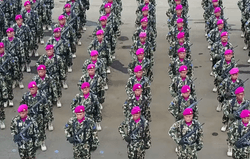
The Indonesian Marine Corps (Indonesian: Korps Marinir) officially known as KORMAR, "Marinir" or "Korps Marinir" is an integral part of the TNI-AL. It is sized at the military corps level serving as the Naval Infantry and main amphibious warfare force of the TNI. Distinguished from other TNI-AL members by their unique qualification badges and insignia and unique magenta berets. It is commanded by a two star ranked officer. It has three divisions, which are:
- Pasukan Marinir I (PASMAR I) (Marine Force I) based in Jakarta.
- Pasukan Marinir II (PASMAR II) (Marine Force II) based in Surabaya.
- Pasukan Marinir III (PASMAR III) (Marine Force III) based in Sorong.[9]
The three marine divisions are each led by a one star ranked officer.
Special Forces
KOPASKA

Formed in 31 March 1962, Frogman Commando (Komando Pasukan Katak) or KOPASKA is a Frogman unit of the TNI-AL. There are three units with detachments specializing in sabotage / anti-sabotage (terror), special operations, combat SAR, EOD and naval minesweeping, underwater demolition and special boat units. KOPASKA's main duties are underwater demolition (raiding enemy ships and bases), destroying main underwater installations, reconnaissance, prisoner snatches, preparing beaches for larger naval amphibious operations, and counter-terrorism. In peacetime the unit deploys a seven-person team to serve as security personnel for VIPs.
Taifib
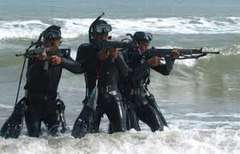
Amphibious reconnaissance battalion (Battalion Intai Amfibi) or Taifib is an elite recon unit within the Indonesian Marine Corps which is tasked for conducting Amphibious reconnaissance and Special reconnaissance. Taifib was previously known as "Kipam" (abbreviation from: "Komando Intai Para Amfibi") which literally means in English: the Para-Amphibious reconnaissance Commandos.
They were officially formed on 13 March 1961 as marine commandos.[10] Set at a regimental strength of two battalions, "Taifib" was formed as the elite amphibious reconnaissance unit of the Marine Corps.
Denjaka
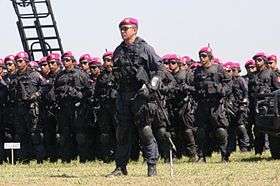
Jala Mangkara Detachment (Detasemen Jala Mangkara) or Denjaka is the special operations and counter-terrorism forces of the Indonesian Navy. This is a combined detachment formed from selected personnel of the Navy's Underwater Special Unit ( Kopaska) and the Marine Corps' Amphibious Reconnaissance Battalion (Taifib). The unit was formed in 1984 by the Chief of the Indonesian Armed Forces to counter maritime strategic threats including terrorism and sabotage. Despite the specific reason for its formation, as in the case of any other special operations forces around the world, the detachment is also fully trained in conducting reconnaissance, unconventional warfare, and clandestine behind-enemy-lines operations. Denjaka's primary task is to develop anti-terrorism, anti-sabotage and other clandestine operations capabilities in support of maritime counter-terrorism, counter-sabotage and other special operations as directed by the commander of the armed forces.
Ongoing projects
The Indonesian Navy is progressing the Minimum Essential Force plan to replenish and modernise the fleet, this includes achieving 151 vessels (minimum), 220 vessels (standard), or 274 vessels (ideal), for which it has a blueprint out to 2024.[11] Some of those platforms yet to be delivered include:
- Martadinata-class frigate As of January 2018, the first two of four Martadinata-class frigates were commissioned into service.[12]
- Nagapasa-class submarines As of April 2019, two South Korean Daewoo Shipbuilding & Marine Engineering (DSME)-built Nagapasa-class submarines were commissioned into service and a third Indonesian state-owned shipbuilder PT PAL Indonesia-built submarine was undergoing sea trials. A contract for three more Nagapasa-class submarines was signed with DSME in April 2019 with completion of the final boat anticipated in 2026.[13]
In January 2020 the Indonesian Minister of Defence Prabowo Subianto during a bilateral meeting in France and met with his French counterpart Florence Parly said the Ministry is interested on French military equipment including 48 Dassault Rafale, four Scorpène submarines, and two Gowind corvettes.
Integrated Maritime Surveillance Systems
With various coastal radars, Indonesia has one of the world's longest Integrated Maritime Surveillance Systems (IMSS). The network covers more than 1,205 kilometres (749 mi) of coastline in the Straits of Malacca and about 1,285 kilometres (798 mi) of coastline in the Sulawesi Sea.[14]
The IMSS is a tightly integrated network of ship and shore based sensors, communications devices, and computing resources that collect, transmit, analyze and display a broad array of maritime data including Automatic Identification System (AIS), surface radar, surveillance cameras, Global Positioning System (GPS), equipment health monitors and radio transmissions of maritime traffic in wide operating areas. Redundant sensors and multiple communication paths make the IMSS a robust and capable system. The IMSS enhances Indonesia's ability to detect, track, and monitor vessels passing through territorial and international waters. This capability is crucial to combating piracy, illegal fishing, smuggling, and terrorism within and around Indonesia's maritime borders. The IMSS is manned and operated by the Indonesian Navy, and consists of 18 Coastal Surveillance Stations (CSS), 11 Ship-based Radars, two Regional Command Centers, and two Fleet Command Centers (Jakarta and Surabaya).[15]
Chief of Staff of the Navy
Rank structure
In the navy, as well as in other armed forces branches in Indonesia, the rank consists of officer in Indonesian known as "Perwira", NCO "Bintara" and enlisted "Tamtama".
The Indonesian Navy is one of few navies in the world which use rank titles similar to its Army, except for flag officers and lower-ranking enlisted sailors. However the Indonesian Marine Corps, which is a branch of the Navy, uses exactly the same rank titles as those of the Army, but still uses Navy-style insignia (for lower-ranking enlisted marines, blue are replacing the red colour). Starting 2006, navy personnel assigned abroad are authorized to use foreign service uniform, officially named "Black Navy" (similar to service dress blues in United States Navy) during their service overseas (e.g. during training exercises), which includes sleeve and cuff insignia.[16][2]
The proper title to address rank are as follows, all high-ranking officers (Admiral or Marine General) use their rank followed by "(TNI)", while other officers use their rank followed by respective branch/corps. For example, a Navy captain from fleet forces corps uses the title "Kolonel Laut Pelaut" (written as "Kolonel Laut (P)"), while a Navy Vice Admiral uses the title "Laksamana Madya (TNI)" regardless of their previous branches. Warrant officers, NCOs and enlisted seamen may put their respective branch/corps specialty, for example: "Pembantu Letnan Dua SAA" (warrant officer from surface weaponry corps) and "Kelasi Dua TRB" (seaman recruit from torpedo corps). All marine corps personnel, general officers inclusive, use their rank followed by "(Mar)".[17]
Note: Indonesia is not a member of NATO, so there is not an official equivalence between the Indonesian military ranks and those defined by NATO. The displayed parallel is approximate and for illustration purposes only.
Note: The red banding on the rank insignia denotes the personnel holding a command position which is agnostic of rank.
Officers
| Equivalent NATO code | OF-10 | OF-9 | OF-8 | OF-7 | OF-6 | OF-5 | OF-4 | OF-3 | OF-2 | OF-1 | OF(D) and student officer | |||||||||||||||||||||||||
|---|---|---|---|---|---|---|---|---|---|---|---|---|---|---|---|---|---|---|---|---|---|---|---|---|---|---|---|---|---|---|---|---|---|---|---|---|
(Edit) |
 |
 |
 |
 |
 |
 |
 |
 |
 |
 |
 |
|||||||||||||||||||||||||
| Laksamana Besar | Laksamana | Laksamana Madya | Laksamana Muda | Laksamana Pertama | Kolonel | Letnan Kolonel | Mayor | Kapten | Letnan Satu | Letnan Dua | ||||||||||||||||||||||||||
| Admiral of the Fleet | Admiral | Vice Admiral | Rear Admiral | Commodore | Colonel | Lieutenant Colonel | Major | Captain | First Lieutenant | Second Lieutenant | ||||||||||||||||||||||||||
| Sleeve | No insignia | -O11.svg.png) |
-O10.svg.png) |
-O9.svg.png) |
-O8.svg.png) |
-O7.svg.png) |
-O5.svg.png) |
-O4.svg.png) |
-O3.svg.png) |
-O2.svg.png) |
-O1.svg.png) |
|||||||||||||||||||||||||
Enlisted ratings
| Equivalent NATO code | OR-9 | OR-8 | OR-7 | OR-6 | OR-5 | OR-4 | OR-3 | OR-2 | OR-1 | |||||||||||||||||||||||||||
|---|---|---|---|---|---|---|---|---|---|---|---|---|---|---|---|---|---|---|---|---|---|---|---|---|---|---|---|---|---|---|---|---|---|---|---|---|
(Edit) |
 |
 |
 |
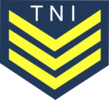 |
 |
 |
 |
 |
||||||||||||||||||||||||||||
| Pembantu Letnan Satu | Pembantu Letnan Dua | Sersan Mayor | Sersan Kepala | Sersan Satu | Sersan Dua | Kopral Kepala | Kopral Satu | Kopral Dua | Kelasi Kepala | Kelasi Satu | Kelasi Dua | |||||||||||||||||||||||||
| Chief Warrant Officer | Warrant Officer | Master Chief Petty Officer First Class | Master Chief Petty Officer Second Class | Senior Chief Petty Officer | Chief Petty Officer | Petty Officer First Class | Petty Officer Second Class | Petty Officer Third Class | Seaman | Seaman Apprentice | Seaman recruit | |||||||||||||||||||||||||
See also
References
- "UU No. 34 Tahun 2004 tentang Tentara Nasional Indonesia" [Law No. 34/2004 on National Armed Forces]. Act No. 34 of 2004 (PDF).
- "Tradisi TNI Angkatan Laut - Pewarisan nilai-nilai luhur dalam membangun semangat juang dan karakter prajurit matra laut" (PDF) (in Indonesian). Dinas Perawatan Personel TNI Angkatan Laut. 2020. Retrieved 11 May 2020.
- "The assassination of generals on the morning of 1 October was not really a coup attempt against the government, but the event has been almost universally described as an 'abortive coup attempt,' so I have continued to use the term." Crouch 1978, p. 101.
- "Peraturan Presiden Republik Indonesia Nomor 66 Tahun 2019 Tentang Susunan Organisasi Tentara Nasional Indonesia" [Presidential Decree Number 66 Year 2019 Regarding Organization of Indonesian National Armed Forces]. Presidential decree No. 66 of 2019 (PDF) (in Indonesian). President of Indonesia.
- IISS Military Balance 2007, p.353
- JDW 19 November 2003, p.16-17
- "Akan Ada 3 Komando Armada TNI AL, Pangarmatim Jadi Armada Pusat RI". 27 February 2015. Archived from the original on 23 May 2017. Retrieved 30 April 2017.
- "Koarmada III TNI AL Diresmikan Panglima TNI". 12 May 2018. Archived from the original on 13 May 2018. Retrieved 12 May 2018.
- "Satgas Koarmada III dan Pasmar 3 siap diberangkatkan ke sorong papua". Archived from the original on 13 May 2018. Retrieved 12 May 2018.
- "Yontaifib Marinir: Pasukan Elit Marinir TNI AL - HobbyMiliter.com". HobbyMiliter.com. 16 December 2016. Archived from the original on 1 August 2018. Retrieved 28 April 2017.
- "Indonesia Targetkan Miliki 154 Kapal Perang Hingga 2024". JakartaGreater. Archived from the original on 2 May 2016. Retrieved 25 May 2016.
- "News". detik.com. 10 January 2018. Retrieved 19 February 2020.
- "Indonesia order 3 more Type 209/1400 diesel electric submarines from South Korea".
- "News". Embassyofindonesia.org. 1 July 2010. Archived from the original on 9 March 2012. Retrieved 7 November 2013.
- "News". id.usembassy.gov. 19 February 2020. Retrieved 19 February 2020.
- Burhani, Ruslan (1 August 2006). "TNI AL Gunakan Seragam Baru Hitam Putih Berstandar Internasional". Antara. Archived from the original on 5 April 2018. Retrieved 5 April 2018.
- "Peraturan Pemerintah Republik Indonesia Nomor 39 Tahun 2010 Tentang Administrasi Prajurit Tentara Nasional Indonesia" [Government Regulation No 39 Year 2010 Regarding Administration of Armed Forces Personnel]. No. 39 of 2010 (PDF) (in Indonesian). Government of Indonesia.
External links
| Wikimedia Commons has media related to Indonesian Navy. |
.svg.png)